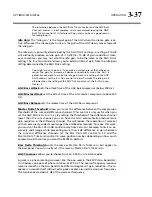
OPTIMOD-FM DIGITAL
OPERATION
3-27
also modify the Factory Preset (with Basic Modify, Full Modify, or Advanced Modify)
before you create your User Preset.
In general, you should be conservative when equalizing modern, well-recorded pro-
gram material.
Except for
B
ASS
G
AIN
, most of the factory presets use less than 3 dB of equalization.
Bass Shelf Controls
, the Five-Band
structure’s low bass equalization
controls are designed to add punch
and slam to rock and urban music.
They provide a parametric shelving
equalizer with control over gain,
hinge frequency, and slope (in
dB/octave).
BASS FREQ
sets the frequency
where shelving starts to take effect.
BASS GAIN
sets the amount of bass boost ( dB) at the top of the shelf.
BASS SLOPE
sets the slope ( dB/octave) of the transition between the
top and bottom of the shelf.
Because the Five-Band structure often increases the brightness of program material,
some bass boost is usually desirable to keep the sound spectrally well balanced. Ad-
justment of bass equalization must be determined by individual taste and by the re-
quirements of your format. Be sure to listen on a wide variety of radios — it is possi-
ble to create severe distortion on poor quality speakers by over-equalizing the bass.
Be careful!
The moderate-slope (12 dB/octave) shelving boost achieves a bass boost that is more
audible on smaller radios, but which can sound boomier on high-quality receivers.
The steep-slope (18 dB/octave) shelving boost creates a solid, punchy bass from the
better consumer radios with decent bass response. The 6 dB/octave shelving boost is
like a conventional tone control and creates the most mid-bass boost, yielding a
“warmer” sound. Because it affects the mid-bass frequency range, where the ear is
more sensitive than it is to very low bass, the 6 dB/octave slope can create more ap-
parent bass level at the cost of bass “punch.”
There are no easy choices here; you must choose the characteristic you want by iden-
tifying your target audience and the receivers they are most likely to be using. Re-
gardless of which curve you use, we recommend a +2 to +5 dB boost for most for-
mats. Larger amounts of boost will increase the gain reduction in the lowest band of
the multiband compressor, which may have the effect of reducing some frequencies.
So be aware the large fixed bass boosts may have a different effect than you expect
because of the way that they interact with the multiband compressor.
Low Frequency Parametric Equalizer
is a specially designed parametric equalizer
whose boost and cut curves closely emulate those of a classic Orban analog para-
Hz
55
110
220
440
0 dB
+3 dB
+6 dB
Bass Gain
Bass Shelf Hinge Frequency
6dB/oct
12dB/oct
18dB/oct
Bass Slope
Summary of Contents for OPTIMOD-FM 8500S
Page 1: ...Operating Manual OPTIMOD FM 8500S Digital Audio Processor Version 1 0 Software...
Page 7: ...Operating Manual OPTIMOD FM 8500S Digital Audio Processor Version 1 0 Software...
Page 26: ......
Page 56: ......
Page 164: ......
Page 308: ......
Page 310: ...6 28 TECHNICAL DATA ORBAN MODEL 8500S CONTROL BOARD PARTS LOCATOR...
















































